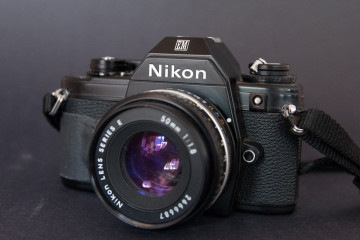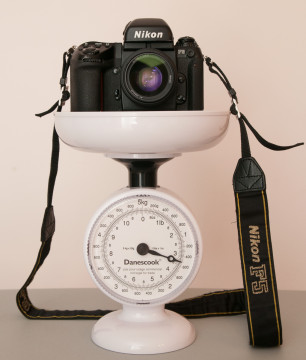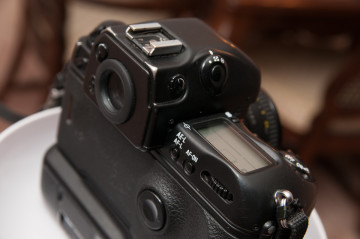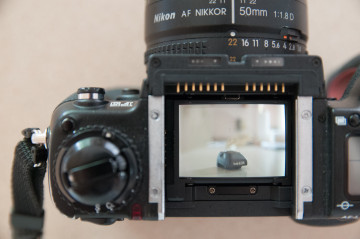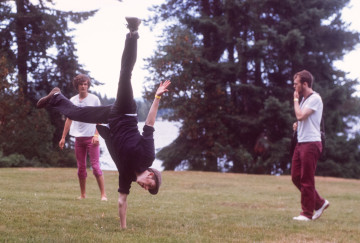Nested in the vegetable crisper of my fridge is a Ziploc bag of film (above the carrots but below the green onions). It’s mostly cheap stuff: Fuji Superia in various speeds, grainy Kodak Gold. Sometimes, though, I pick up a roll of slide film (Fuji Provia 100F, to be exact), and I save it for a special occasion, since it’s too expensive to use each day. The question of when I’ll use it will easily be answered when the day arrives, but the question of which camera to put it in is one I wonder about.
My usual film camera, the Nikon EM, is slow. It makes pictures that are deliberate and thoughtful. Each rich but concise, 36-exposure story is told over a glass of brandy by the fire. Digital, though, is a little different. Among the thousands of frames are a handful of rough gems waiting to be polished in my computer. The speed of digital, combined with cheap digital memory, allows photographers to make a ludicrous number of exposures in rapid succession, so the impatience that permeates my digital work simply isn’t in my film shots.
Before digital, this distinction didn’t exist. Generally, a film camera was just a light-tight box. You could put the same fancy slide film in any camera and, with a similar lens, the shot would look just as nice. Not everyone had a heavy motor-driven film advance, though, so pictures were shot one frame at a time. With a 36-exposure limit, film was a precious commodity, so you used what you had. Spraying and praying was out of the question for most film cameras, but not all.
Meet the Nikon F5. Produced from 1996–2003, it is the last Nikon film camera meant for the working news photographer. Technically, the F5 has a successor, but the F6 is a more refined tool, a swan song of a camera meant for the discerning collector, not the bedraggled pro. The F5’s predecessor (logically called the F4), could not keep up with its Canon counterpart, so the F5 was developed with only one word in mind: speed. It advances film so quickly it can finish a 24 exposure roll of film in 3 seconds.
As digital cameras weren’t quite ready for primetime, film needed to keep up with the increasingly fast pace of news gathering, and the F5 was the quintessential example. Thanks to an impossibly good deal on Used Victoria, I got to see if film was really meant to be shot at those kinds of speeds.
On paper, the F5 is better than my EM in every way. It’s faster, more durable and more accurate. Its ruggedness in particular can’t be overstated. The original F famously stopped a bullet meant for Don McCullin, a photojournalist during the Vietnam War, and I feel like my F5 could do the same. It is sealed against dust and moisture and its all-metal construction makes it a dependable companion in the field. It weighs 1.2 kg without batteries, lenses or accessories, so it could serve as a bludgeon in a pinch.
The F5 is tough, but it’s also highly advanced. In many ways, it’s actually more sophisticated than my digital cameras. It can use my existing set of modern lenses whereas the EM can’t. As a daily shooter, though, the F5 is woefully impractical. Its voracious appetite for film and batteries could bankrupt me. So why the hell did I buy this thing? Besides the incredible deal I got, I wanted to see if I could reconcile the different attitudes I have towards shooting film and digital.
It’s common now for avid photographers to use film exclusively for their personal work. Because of this, I feel like I missed out on the experience of shooting a make-or-break assignment on film. Before the migration to CMOS sensors, celluloid was the only game in town, and without a delete key or an LCD, pros worked with a tightly limited number of frames, a fixed ISO and no idea if the pictures they shot were worth a damn. An enormous gulf separates my EM from my current digital camera, a D300, so to narrow the gap between digital and film, I got the fastest, most powerful 35mm camera I could acquire. So why the mixed feelings?
Contrary to what I first thought, I enjoyed the distinction. I like my digital and film work, just for different reasons. The speed and instant feedback of digital makes me less hesitant to jump on a fleeting moment since I’m not worried about failing. While I can capture a slower action like a hug with my film camera, I could never hope to capture a glance or a split-second laugh that I could with my digital cameras. Besides, the geek in me loves to blow up an image to 100 per cent and make sure each eyelash is perfectly crisp, and that level of detail isn’t possible with most film.
In my experience, the F5’s speed actually works against it. I’ve only had it for a few weeks, and judging from my initial roll of pictures, my EM could have done exactly the same thing with fewer wasted exposures. In addition, its small size makes it a far less intimidating camera than the monstrous F5.
Practically speaking, the fast pace of modern journalism relies on an all-digital workflow. Photographers race to upload their images minutes after they shoot them, and the first one to upload their photo on the wire will have their shot used. As fast as the F5 is, it’s still film, which has to be developed off-site. Other than the time, I shudder to think how much it would cost to develop eight rolls of film after every sporting event.
Film, though, is perfect for hanging out with friends. Why? It’s slow paced, relaxed. To me, it’s just the kind of format it is. I can still see film being used for certain applications, like outdoor portraits or more artistic applications (the nostalgia-steeped work of Olivia Bee comes to mind), but digital is just so much better for news gathering. Just because the camera can shoot it at 7.4 frames per second doesn’t mean you should do it. To me, the F5 just misses the point.
So, when the time comes, I’ll be putting that roll of Fuji Provia in my humble EM. I still look forward to using my F5 from time to time, though. It’ll make an interesting portrait camera, or failing that, the world’s most sophisticated hammer.



